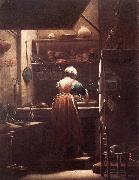Wholesale Oil Painting No Minimum |
|||||||||||
|
|
|||||||||||

|
|||||||||||
|
|
|
||||||||
Giuseppe Maria Crespi1665-1747 Italian Giuseppe Maria Crespi Locations 1747). Painter, draughtsman and printmaker. His religious and mythological works are distinguished by a free brushstroke and a painterly manner. He also painted spirited genre scenes, which by their quality, content and quantity distinguish him as one of the first Italian painters of high standing to devote serious attention to the depiction of contemporary life. Such paintings as Woman Laundering (1700-05; St Petersburg, Hermitage) or Woman Washing Dishes (1720-25; Florence, Uffizi) offer straightforward glimpses of domestic chores in images that are startlingly novel for the period and look forward to the art of Jean-Simeon Chardin, Jean-Francois Millet and Honore Daumier |
||||||||
|
|
||||||||
Saul Attacking David
Saul Attacking David Painting ID:: 51217 |
1710-15
Oil on canvas 1710-15 Oil on canvas |
|||||||
|
|
||||||||
|
GUERCINO Italian Baroque Era Painter, 1591-1666 best known as Guercino or Il Guercino, was an Italian Baroque painter from the region of Emilia, and active in Rome and Bologna. Guercino is Italian for squinter, a nickname that was given to him because he was cross-eyed. He is especially noted for his many superb drawings. Guercino was born at Cento, a village between Bologna and Ferrara. By the age of 17 he was associated with Benedetto Gennari, a painter of the Bolognese School. By 1615 he moved to Bologna, where his work earned the praise of an elder Ludovico Carracci. He painted two large canvases, Elijah Fed by Ravens and Samson Seized by Philistines, in what appears to be a stark naturalist Caravaggesque style (although it is unlikely he had been able to see any of the Roman Caravaggios first-hand). They were painted for Cardinal Serra, Papal Legate to Ferrara. The Arcadian Shepherds (Et in Arcadia ego) was painted in 1618 contemporary with The Flaying of Marsyas by Apollo in Palazzo Pitti. His first style, he often claimed, was influenced by a canvas of Carracci in Cento. Some of his later pieces approach rather to the manner of his great contemporary Guido Reni, and are painted with more lightness and clearness. Guercino was esteemed very highly in his lifetime. He was then recommended by Marchese Enzo Bentivoglio to the Bolognese Ludovisi Pope, Pope Gregory XV. His two years (1621-23) spent in Rome were very productive. From this stay date his frescoes of Aurora at the casino of the Villa Ludovisi and the ceiling in San Crisogono (1622) of San Chrysogonus in Glory; his portrait of Pope Gregory (now in the Getty Museum, and, what is considered his masterpiece, The Burial of Saint Petronilla or St. Petronilla Altarpiece, for the Vatican (now in the Museo Capitolini). The Franciscan order of Reggio in 1655 paid him 300 ducats for the altarpiece of Saint Luke Displaying a Painting of the Madonna and Child (now in Nelson-Atkins Museum of Art, Kansas City). The Corsini also paid him 300 ducats for the Flagellation of Christ painted in 1657. Saul Attacking David 1646 Oil on canvas, 147 x 220 cm Galleria Nazionale d'Arte Antica, Rome This painting was executed along with a pendant, now in Los Angeles, that depicts Samson showing his hair - secret of his superhuman strength - to Delilah. Guercino painted the pair of canvases in 1646 for the Cardinal Falconieri, who was at the time serving as Papal Legate to Bologna. The two paintings were separated at the end of the eighteenth century. Guercino's increasing tendency towards classicism began in the 1630's when the painter fell under the influence of the late work of Guido Reni. Like its pendant, the Saul Attacking David is a splendid example of his late style, a period in which Guercino brought his investigations into classicising style to their fullest conclusion. Despite the dramatic quality of the narrative, the composition of the painting is extremely balanced: everything centres on the monumentality of the two figures, contrasting protagonists of the scene. Almost frozen in their action, they are displayed entirely in the foreground, as if in a relief sculpture. The chromatic range, light and highly refined, is rather far from the richly impasted mode of the artist's youth, as is the way in which the shadows ably underline the plastic quality of the two personages.Artist:GUERCINO Title: Saul Attacking David Painted in 1601-1650 , Italian - - painting : religious |
||||||||
|
|
||||||||
|
Prev Next
|
||||||||
|
|
||||||||
|
Related Paintings to GUERCINO :. |
||||||||
|
|
||||||||
|
CONTACT US |

